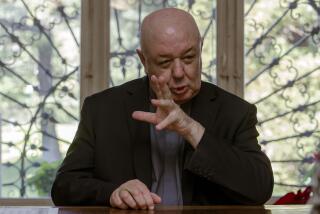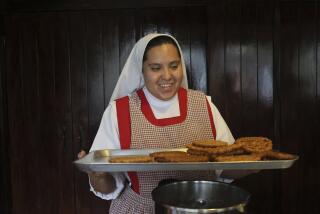Discarded Boxes Crafted Into Creches for the Pope : Craftsmanship: A Vatican envelope-maker’s skill at fashioning nativity scenes spread until he was asked to make one for Pope John Paul II.
- Share via
VATICAN CITY — Antonio Dante Zavatta started making things out of paper when he was a 12-year-old in Milan, Italy.
He couldn’t have imagined that four decades later he would be creating Christmas nativity scenes for the Pope.
Seven years ago Zavatta, an envelope-maker in the Vatican press shop, began making creches for his fellow workers.
One would never guess that they were crafted entirely from discarded pasteboard boxes. In his skillful hands, the paper assumes the realistic look of wood, stone and brick.
Zavatta’s creches, varying in size but all small enough to fit on a table, are usually medieval courtyard scenes, instead of the traditional Bethlehem stable setting.
It didn’t take long for word of his extraordinary craftsmanship to spread. Soon he was making creches for Vatican officials. In 1990, at the request of nuns who work in the papal apartments, he made his first nativity scene for Pope John Paul II. It was an old Roman farmhouse, with figurines of the Holy Family in a stable below the house.
This Christmas Zavatta will center the nativity scene for the pontiff’s private chapel around a medieval Vatican gate that no longer exists.
One of Zavatta’s creations will be part of a display of nativity scenes in downtown Rome.
In a city where yuletide creches are as common as pizzas, these are special honors for Zavatta, a slender, modest man of 54 who spends a full year of his lunch hours and spare time fashioning the unconventional manger scenes.
It has been this way since 1984, when Zavatta made his first pasteboard nativity scene, using statues of the Holy Family that a cardinal had given him as a Christmas gift.
“I wanted to do something beautiful,” says Zavatta, who sculpts and paints as a hobby. He now makes six or seven creches a year, giving some of them to friends and associates. Inspiration for the unusual settings comes from a combination of old paintings and Zavatta’s imagination.
He will take no money for his creations. One of his colleagues says that Zavatta has been approached to make creches for stores in Rome, where they would command thousands of dollars.
Zavatta turns down such offers. “It’s a thing I feel inside,” he tells National Geographic. “It’s not a job. That’s why I don’t do it for money. If I didn’t believe in God, I wouldn’t do a thing like this. I would only do it for money.”
Each elaborate scene is different. Under Zavatta’s talented paintbrush, pasteboard comes out looking exactly like wood. Gesso, a mixture of sand, glue and paint, becomes realistic brick and stone. For one scene, Zavatta crafted a tiny bird cage from toothpicks.
He deprecates his deft touch. “It’s a job for children,” he shrugs. “Anyone can do it. For me it’s like a game.”
But it’s not for everyone. Over the years, Zavatta has taught children in Sunday school how to work with paper. To his disappointment, he’s been unsuccessful in infecting any of them with his enthusiasm.


